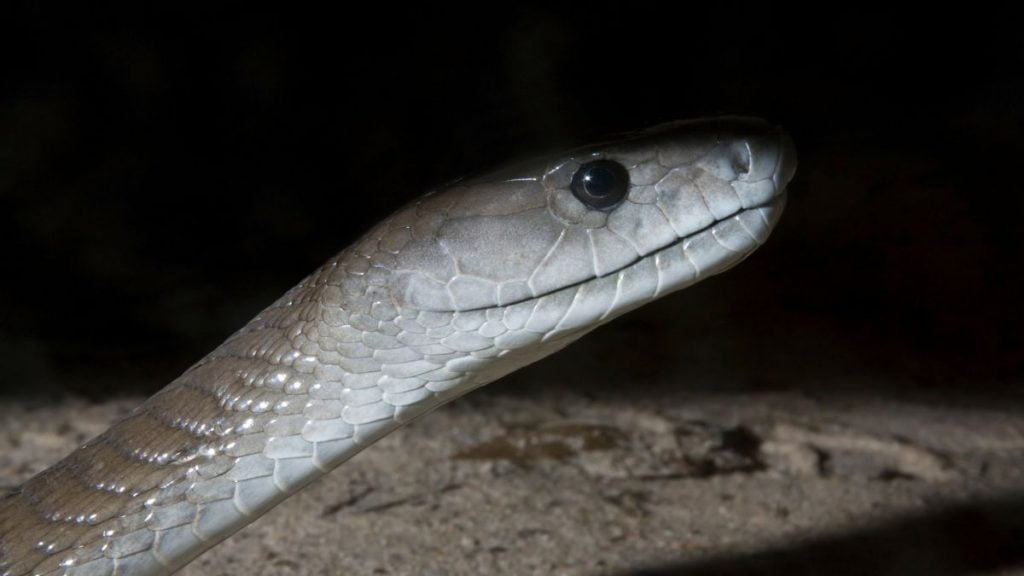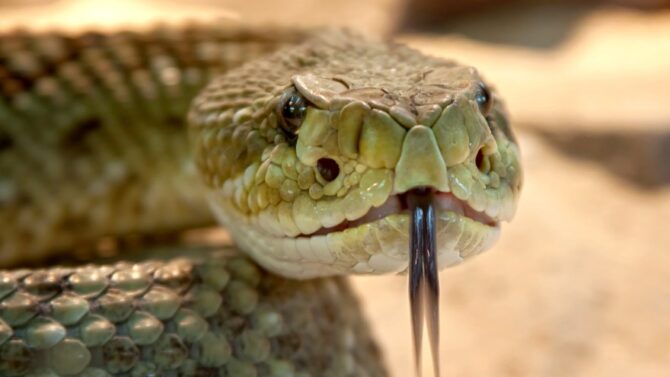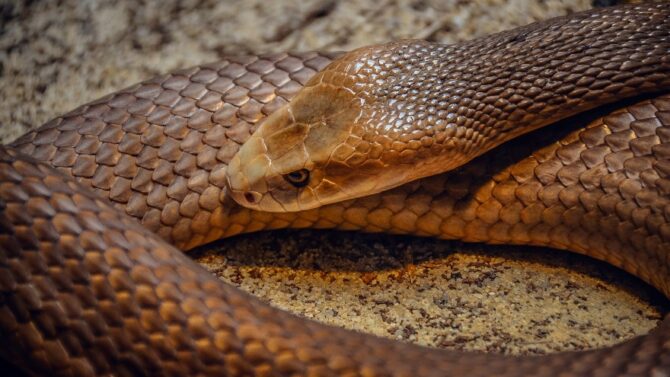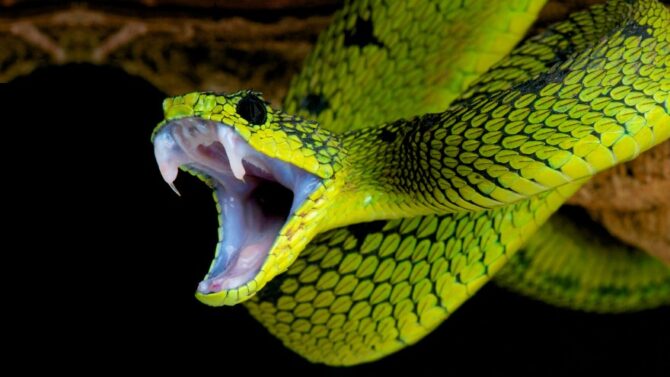Fun fact: Nocturnal snakes are not as dangerous as most people perceive them to be.
There is more to learning about these reptiles than just how deadly some snake species can be. There’s been an argument about the sleep patterns of snakes and their active hours.
The active nature of animals are classified into:
- Diurnal animals — Active during the day.
- Nocturnal animals — Sleep throughout the day and are active at nighttime.
- Crepuscular animals — Active at dawn and dusk.
Considering that these reptiles have a very high level of specialization, the question that begs to be asked is: Are snakes nocturnal, diurnal or crepuscular animals?
Snakes can be nocturnal, diurnal, or crepuscular and it depends on several factors like climate, phases of the moon, species, environment, habitat, presence of predators, and prey.
This rest of this article explains these activity patterns of snakes, gives examples of snakes that follow these patterns, and factors that influence these behaviors.
Snakes: An Overview

Snakes (Serpent of the suborder Serpentes) are species of reptiles with a greatly elongated cylindrical body, a tail, eyes without lids, forked tongue, scaly skin, and are also without external limbs.[1,2,3]
Some experts describes snakes as lizards that have developed over the years and undergone structural depletion, simplification, as well as change in the specialty.
This description is correct because snakes are known to have evolved from terrestrial lizards 174.1 million to 163.5 million years ago.
There are over 3,000 species of snakes on the planet except in places where zero snakes have been recorded like Ireland, Iceland, New Zealand, Cape Verde, Alaska, Antarctica, Siberia, Greenland, Central and Northern Canada, Hawaii, and some small Pacific island nations, etc.[4,5]
Snakes inhabit many ecosystems that include subterranean, arboreal, terrestrial, and aquatic environments, and they live in different temperatures.[6]
It is believed that all snakes are poisonous, but that is not true as a vast majority of snakes (about 600 species) are nonvenomous and are kept as pets by some humans. [7]
Snakes are natural predators and carnivorous animals that can cause harm or prey on other animals they consider Invaders or potential snacks.
They can catch, exploit, and gobble up their prey by using only their body and mouth.
Poisonous snakes will inject extremely toxic poisons to kill their prey, some will tighten themselves around any prey they capture, while others will hold them with their mouths and swallow them.[8]
Some species are more active and come out often to hunt during the day than others, and vice versa.
Are Snakes Nocturnal, Diurnal, or Crepuscular?
Snakes can be either nocturnal, diurnal or crepuscular. They can be active at any time both during the day and night and when it’s time to rest, they do that.
Scientists have come to the conclusion that snakes can use the environment they find themselves to their advantage.
To a large extent, their environment determines their resting and hunting hours.
According to a research by the Austrian Herpetological Society, below are the hunting behaviors of the snakes in Europe:
- 15% of snake species are nocturnal
- 68% of snake species are diurnal
- 17% of snake species are crepuscular
Nocturnal Snakes
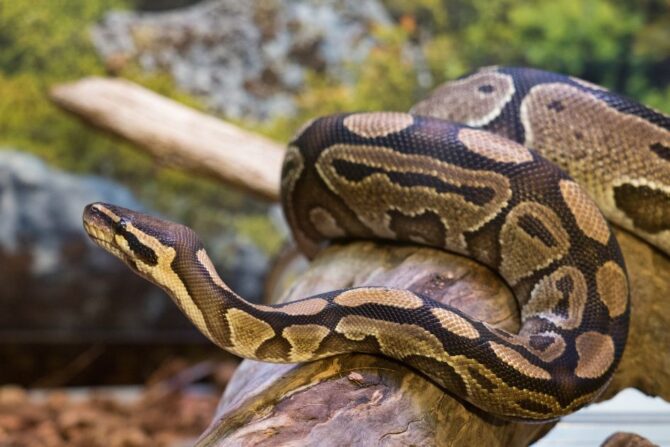
Nocturnal snakes are overly active during dark hours. They have a heat-sensing vision that enables them to adapt to night hunting.
Although not all snakes are nocturnal, there are a lot of them out there.
Some snake species are nocturnal because they find themselves in environments where their preys are more active at night, so they adjust in order to feed.
Being active at night favors them too as they’re safe from diurnal predators.
- Ball Python
- Boa Constrictor
- Woma Python
- Western Taipan
- Rosy Boa
- Philippine Cobra
- Milk Snake
- Kenyan Sand Boas
- Green Anaconda
- Brazilian Rainbow Boa
- African House Snake
- Rattlesnakes (nocturnal during summer)
- Rat Snakes
- Corn Snakes
- Malayan Pit Vipers
Diurnal Snakes
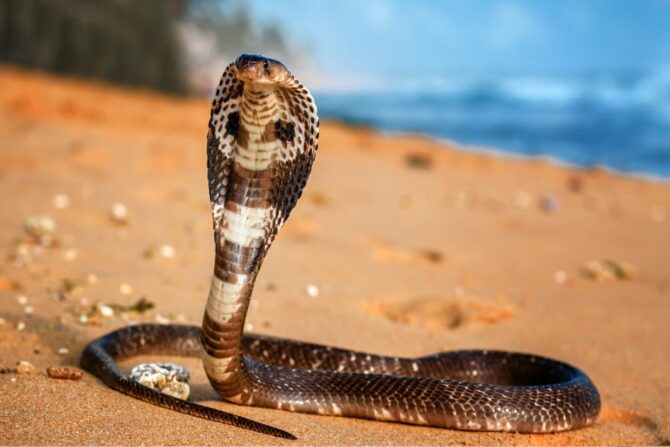
Diurnal snakes are usually active and awake during daylight hours. They sleep at night and come out to hunt and warm themselves in the sun during the day.
Just like other species, they need the sun for synthesizing vitamin D and to balance their body’s temperature.
Examples of diurnal snakes:
- Western Hognose Snake
- King Cobra
- Vipera Darevskii
- Garter Snake
- Gopher Snake
- Eastern Indigos
- Common Brown Snake
- Corn Snakes
- California King Snake (during spring and fall)
- Rat Snake
- Black Mamba
- Copperhead Snake
- Rattlesnakes (during spring and fall)
Crepuscular Snakes
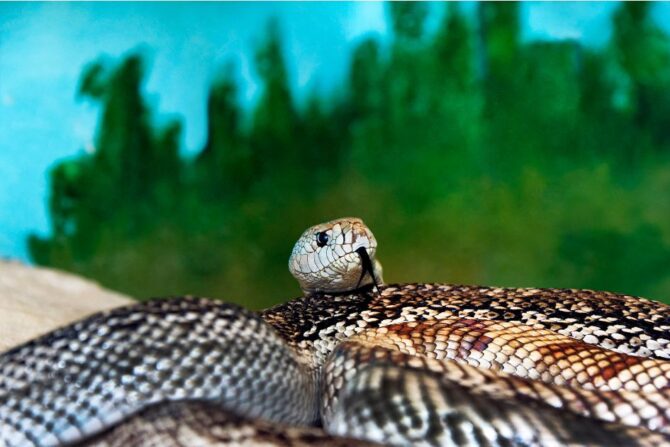
Crepuscular snakes are always active and have a better hunting experience before sunrise and after sunset (twilight periods).[9]
Many species find hunting at dusk and dawn comfortable for them and this is a crepuscular behavior.
Examples of crepuscular snakes:
- Pine Snakes
- MacClelland’s Coral Snakes
- Arabian Whip Snakes
- California King Snakes (during summer)
Factors That Influence Nocturnal, Diurnal & Crepuscular Behavior In Snakes
Species
We can’t accurately determine if a snake will be nocturnal, diurnal, or crepuscular because of the different extant species. The activity patterns of different snakes varies.
Prey
If a snake’s prey comes out during twilight hours, there is a huge possibility of the snake displaying similar behavior in order to achieve the best hunting experience.
Temperature
Snakes are cold-blooded animals that rely on the external surroundings to regulate their body temperature.
When the temperature of its environment rises, the snake’s body temperature will rise too. When it drops, its body temperature will drop too.
In cold temperatures, snakes will become less active and enter brumation, while in hot temperatures, snakes are commonly hanging out in tall grass or staying beneath covers like rocks, shady trees, decks, or porches.[10]
Climate
In cooler climates, snakes tend to lie dormant as a means of getting through the cold. These snakes will seek out places that will keep them warm.
On days when the sun comes out strong, they will emerge to get heat from the sun to boost their body’s temperature and hunt before going back to being inactive.
Environment and Habitat
Snakes that live in aquatic environments are more nocturnal than the ones in terrestrial habitats.
This is because the fluctuations in water temperature are less than the ones in the air and this makes them more active at night.
Also, aquatic snakes are mostly nocturnal because they need less sun than their land counterparts.
They spend their days in very deep waters and the sunlight is not as necessary to them as it is to other species.
Full Moon
Snakes will be more inclined to go out to hunt at night when there is a full moon. Although a full moon benefits snakes, it can also increase predation.
FAQs
What Are Night Snakes?
Night snakes (Hypsiglena torquata) are small snakes with rear fangs. They are about 30–66 cm long and they come in colors like gray and light brown with blotches on their backs and sides with a white and sometimes yellowish belly.
Night snakes just like the name implies are active during nighttime (meaning they are nocturnal animals). They can also be crepuscular reptiles as they are usually seen at dawn and dusk.[11]
Wrap Up
Snakes can be nocturnal, diurnal, or crepuscular. In different environmental conditions, they can choose to be more active during the day than at night.
Some other factors also determine the activity patterns of snakes.
It is important to know that all snake species need sun. Hence, not every snake active during dark hours is entirely nocturnal.
References & Notes
- https://www.britannica.com/animal/snake
- https://doi.org/10.1016/B978-0-12-386454-3.00786-7
- https://www.encyclopedia.com/plants-and-animals/animals/vertebrate-zoology/snake
- https://www.nationalgeographic.com/animals/reptiles/facts/snakes-1
- https://www.nationalgeographic.com/animals/article/snakeless-in-ireland-blame-ice-age-not-st-patrick
- https://bmcecolevol.biomedcentral.com/articles/10.1186/s12862-015-0358-5#ref-CR1
- Mark A. Mitchell & Thomas N. Tully, Jr., (ed.) 2009, “Manual of Exotic Pet Practice.” ISBN 978-1-4160-0119-5, DOI https://doi.org/10.1016/B978-1-4160-0119-5.X5001-X.
- Laurie J. Vitt & Janalee P. Caldwell, (ed.) 2013, “Herpetology–An Introductory Biology of Amphibians and Reptiles,” Fourth Edition. ISBN 978-0-12-386919-7, DOI https://doi.org/10.1016/C2010-0-67152-5.
- https://en.wikipedia.org/wiki/Crepuscular_animal
- https://varmentguard.com/blog/keep-snakes-away-summer
- https://en.m.wikipedia.org/wiki/Night_snake
Featured Image Credit: Mark Kostich/Getty Images Signature
